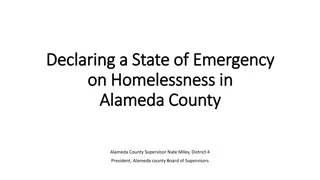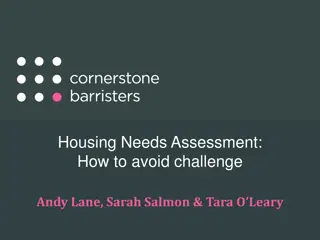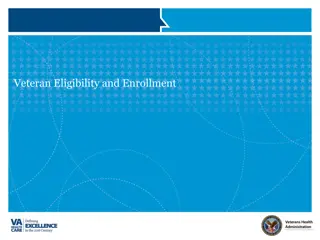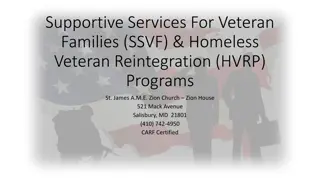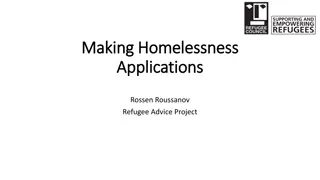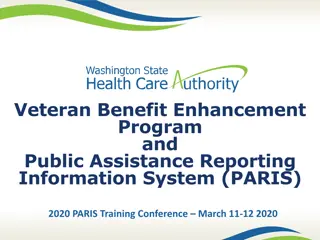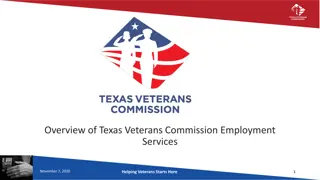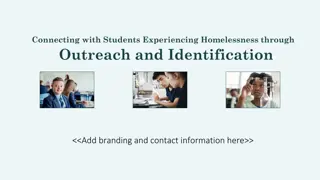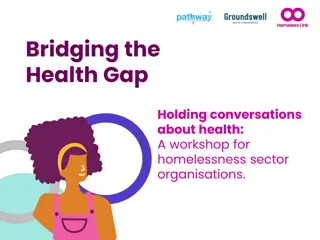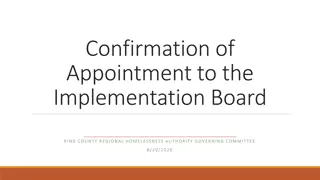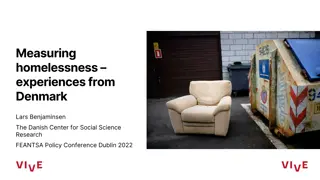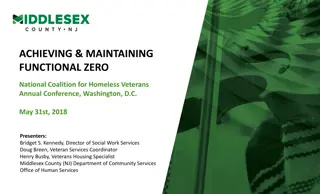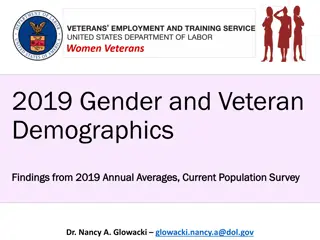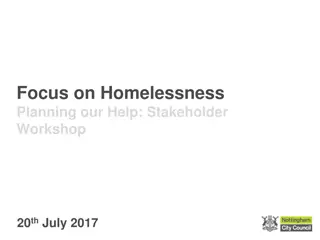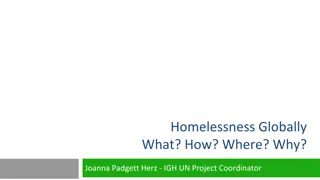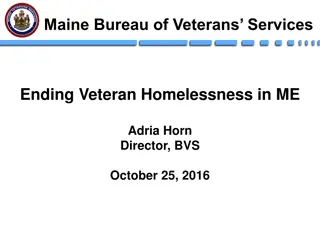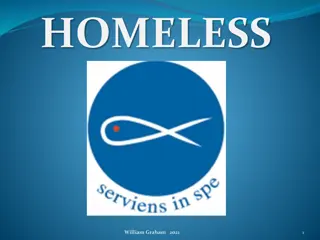Addressing Veteran Homelessness in the United States
Various initiatives and reports highlight the challenges faced by homeless veterans in the United States, emphasizing the need to tackle root causes such as lack of affordable housing, insufficient income, and mental health issues. Demographic insights reveal the typical characteristics of homeless veterans, with a focus on post-Vietnam era veterans. Efforts are being made to provide support and housing options to reduce the number of homeless veterans, especially those who served in the OEF/OIF conflicts and are affected by behavioral health issues.
Download Presentation

Please find below an Image/Link to download the presentation.
The content on the website is provided AS IS for your information and personal use only. It may not be sold, licensed, or shared on other websites without obtaining consent from the author.If you encounter any issues during the download, it is possible that the publisher has removed the file from their server.
You are allowed to download the files provided on this website for personal or commercial use, subject to the condition that they are used lawfully. All files are the property of their respective owners.
The content on the website is provided AS IS for your information and personal use only. It may not be sold, licensed, or shared on other websites without obtaining consent from the author.
E N D
Presentation Transcript
Eliminating Homelessness Among Veterans Pete Dougherty Department of Veterans Affairs Homeless Veterans Initiative Office Paul Smits VA National Center on Homelessness Among Veterans
Veteran Homelessness Veteran Homelessness: A Supplemental Report to the Annual Homeless Assessment Report (AHAR) to Congress published in January 2011, estimated that on any given night in 2009 there were approximately 76,000 homeless Veterans. An estimated 136,000 Veterans were homeless over the course of a year. We will provide new help for homeless Veterans because those heroes have a home it s the country they served, the United States of America. -President Obama (March 16, 2009) We are going to take (the) 131,000 homeless Veterans off the streets over the next five years . . . To do this well, we will have to attack the entire downward spiral that ends in homelessness we must offer education, jobs, treat depression, fight substance abuse, and offer safe housing. We have to do it all no missed opportunities in going from 131,000 to zero and keeping it there . . . - VA Secretary Shinseki (August 18, 2009) 1
Root Causes of Homelessness Lack of Affordable Housing Insufficient Income/Poverty Lack of Health and Supportive Services Lack of Public Assistance Lack of employment opportunities/low wages and Job loss Lack of child support Domestic Violence Drug and Alcohol related problems Physical Illness 2 Mental Illness
Veteran Demographics The Average Homeless Veteran: Served in the post-Vietnam era (1975-1990) Is 51, male, single, equally likely to be African-American or Caucasian Is unemployed and has an income of less than $125 per week At the time of contact is living either outdoors or in a shelter and suffers from medical and mental health/substance use disorders. Minority Veterans are overrepresented (52% of total) in the homeless population. Female Veterans are the fastest growing segment of the homeless 3
OEF/OIF Homeless Vets (Actual and at Risk) FY2010 Males Females Total OEF/OIF Homeless 8,511 1,195 9,706 OEF/OIF served by VHA 339,072 22,727 361,799 Proportion Homeless Source VA Inpatient and Outpatient Encounter database (October 2010) 2.5% 5.3% 2.6%
Behavioral Health Diagnoses for Homeless OEF/OIF Vets Diagnosis (ICD-9) Percent PTSD 17.2% Depressive Disorder NEC 7.2% Alcohol Dependence 9.5% Drug Dependence 9.5% Schizophrenic disorders 1.5% Major Depressive Disorders 4.0% Bipolar Dis. 1.9% Anxiety Disorders 4.0%
Veteran Homelessness In November 2009, Secretary Shinseki announced a comprehensive plan to ensure no Veteran willing to accept services remains on the streets in five years. The plan focuses on the prevention of homelessness, permanent supportive housing, mental health and substance abuse treatment, education and employment assistance. The plan to End Homelessness Among Veterans is built upon Six Strategic Pillars Outreach/Education Treatment Prevention Housing/Supportive Services Income/Employment/Benefits Community Partnerships 6
Outreach & Education National Call Center: VA established a 24/7/365 National Call for Homeless Veterans (1-877-424-3838). Trained staff respond to more than 2,500 calls for information and assistance monthly. VA s goal is to reduce homelessness among Veterans by conducting outreach to those who are the most vulnerable and are not currently receiving services and engaging them in housing, treatment and rehabilitative programs. VA can provide contract residential care for Veterans with serious mental health diagnoses with quality community bed-based services. VA continues efforts to improve access to services, create new connections both within and outside VA and educate providers and Veterans regarding VA homeless services and benefits. 7
Outreach & Education Stand Downs are 1-3 day events sponsored by community agencies in partnership with VA in an effort to reach and provide service to homeless Veterans. There were 196 Stand Downs reported in 2010 in 50 states, the District of Columbia, and Puerto Rico 50,020 Veterans and family members were served 40,729 male Veterans 3,596 female Veterans 5,905 spouses 1,790 children 8
Treatment Health Care: Homeless Veterans suffer from high rates of mental and physical health problems often exacerbated by their living conditions. 59% Medical (physical) Problems 55% Mental Health Problems 67% Substance Use Problems 9
Treatment Dental Care for Homeless Veterans: VA may provide a one-time course of treatment for homeless Veterans in a VA supported transitional housing (Grant and Per Diem Program) and Domiciliary Care for Homeless Veterans. These efforts improve Veteran s health and opportunities to regain employment. In FY 2010, 11,129 Veterans received dental treatment. 10
Treatment Domiciliary Care for Homeless Veterans (DCHV): VA s Domiciliary Program provides time-limited residential treatment to homeless Veterans with health care and social-vocational deficits. DCHV programs provide homeless Veterans access to medical, psychiatric, and substance use disorder treatment in addition to social and vocational rehabilitation programs. 2,400 beds for homeless Veterans FY 2010 Provided residential rehabilitation treatment for 8,519 homeless Veterans with 54 percent of those independently housed, and over 37% returning to work 11
Housing/ Supportive Services Permanent Housing: Housing and Urban Development-VA Supported Housing (HUD- VASH) Program: HUD provides Housing Choice Vouchers to local Public Housing Authorities where Veteran families can receive housing with VA providing dedicated case managers to assist with health care and benefits assistance. Provides for permanent housing for homeless Veterans and their families. 11% of HUD-VASH vouchers have been used by women Veterans. More than 4,000 children live with Veteran parents in HUD-VASH housing Nearly 30,000 Housing Choice vouchers, 10,000 per year in 2008, 2009, and 2010 have been allocated for homeless Veteran families. 12
Housing/Supportive Services Transitional Housing: Grant & Per Diem Program(GPD) VA may award grants of up to 65% of the cost to state, local, tribal governments and non-profit organizations to acquire, renovate, or rehabilitate a building to create transitional housing programs with limited stays up to 24 months or less for Veterans. This program helps homeless Veterans achieve residential stability, increase their skill levels and/or income, and obtain greater self-determination. VA began awarding funds to this effort in 1994 and more than 700 community agencies in every state, the District of Columbia, Puerto Rico and Guam have received funding to offer transitional housing and supportive services for homeless Veterans, more than 17,000 beds authorized, approximately13,000 beds are operational. 13
Prevention Supportive Service for Low Income Veterans Families (SSVF) Grants: In April 2011,VA began a review of applications from non-profit organizations seeking to assist low income Veterans and their families at risk of homelessness to maintain the current housing or to quickly get them back into permanent housing. VA awarded 85 grants and is rapidly ramping up this new program. Veterans Justice Outreach (VJO): In 2009, VA increased efforts to assist Veterans who were incarcerated or were facing criminal prosecution. This effort includes providing outreach to justice-involved Veterans in 955 (72%) of U.S. state and federal prisons, jails and courts.VJO clinicians have been designated at each of the 153 VA medical centers. 14 .
Prevention Veterans Homelessness Prevention Demonstration Program (VHPD) - Department of Housing and Urban Development Department of Labor (DoL) -Department of Veteran s Affairs Pilot: A five site three-year pilot project designed to provide early intervention to recently discharged Veterans and their families to prevent homelessness. Under this pilot VA provides dedicated staff to work with Veterans and families;HUD provides funds to Continuum of Care (CoC) to pay for needed services; Labor provides access to employment and training services. Sites selected: Camp Pendleton (San Diego, CA), Fort Hood (Killeen, TX), Fort Drum (Watertown, NY), Joint Base Lewis- McChord (Tacoma, WA) and MacDill Air Force Base (Tampa, FL). 15
Income and Benefits VA s Benefits Administration assigns twenty full-time and thirty- seven part- time Homeless Veteran Outreach Coordinators (HVOC) to control and expedite the processing of homeless Veteran claims. VA partners with the Social Security Administration (SSA) to expedite claims for Social Security Disability and with state and local governments for other types of economic assistance to Veterans. VA works with Department of Labor s Homeless Reintegration Program that aids thousands of Veterans returning to employment. VA s Homeless Veterans Supported Employment Program (HVSEP) is a new effort to support Veterans to enhance opportunities to obtain and sustain community employment. HVSEP offers supportive employment services targeting homeless and at-risk Veterans with job development activities and skill building for coping with difficulties at work by providing peer support for coping with employment issues. 16
Community Partnerships This a cornerstone of the plan. VA strives to create partnerships with national and local governmental agencies and with community partners to enhance opportunities and services for homeless Veterans. VA has strengthened its partnerships with community service providers with nearly 4,000 interagency collaboration agreements in place. These agreements have aided the VA in extending outreach services to 2,418 sites such as shelters, soup kitchens, safe havens, welfare offices or other locations where homeless persons may be located and have spurred the development of additional housing resources. VA continues to foster interagency collaboration with: United States Interagency Council on Homelessness (USICH), Departments of Housing and Urban Development, Labor, Education, Health & Human Services, Department of Justice and others. 17
Selected Demographic Characteristics of VA Homeless Program Veterans (FY10) African American (n= 18,795) Hispanic (n=2,919) Caucasian (n=21,256 ) Other (n=1,502) Overall (N=44,472 ) Percent of Total 42.3% 6.6% 47.8% 3.3% 100.0% Average Age 51.3 49.4 50.9 49.0 50.9 Women 5.8% 5.9% 5.0% 9.1% 5.5% OEF/OIF Service 4.1% 10.7% 7.0% 9.7% 6.1% Homeless More Than 1 Year 33.0% 33.6% 33.0% 35.3% 33.0% Source: NEPEC HCHV Form X and DCHV Form Z, 10/1/09-8/31/10 Includes Healthcare for Homeless Veterans (HCHV) Outreach and Domiciliary Care for Homeless Veterans (DCHV) Admissions 18
New Programs and Initiatives to End Homelessness Among Veterans Outreach Safe Havens Housing First Community Resource and Referral Centers (CRRCs) 19
Outreach Reaching Homeless Veterans and Their Families
A New Initiative to Reach Homeless Veterans When: October 12, 2011 How: Simultaneous kick-offs in 28 communities Why: Showcase national scope of VA s commitment to ending homelessness among Veterans Who: VA leadership and staff, community partners, broadcast media, social media 21
Approach A Three Tiered Approach National air cover to carry message to stakeholders, creating an umbrella of general awareness Target 28 locations, based on US Interagency Council on Homelessness (USICH) and Annual Homeless Assessment Report (AHAR) data Leverage community stakeholders and media in rural areas to perform outreach; use lessons learned from five pilot sites to inform development of rural outreach plan 22
Target Audiences First Responders Concerned Citizens & Friends and Relatives of Veterans who Are Homeless (including staff from VA, VHA, VBA, & NCA) VHA & Community Medical Providers 23
Getting the Word Out Billboards Flier Bus Shelter Ads Distribution Public Service Announcements 24
Safe Havens A New Initiative to reach the Chronically Homeless Veteran
Background Authorized by McKinney-Vento Act of 1994 Funded from HUD s Supportive Housing Program Primary mission was to target chronically dually diagnosed homeless that were ineffectively served by traditional homeless programs HUD initially funded 300 Safe Haven programs
Core Principles The Low Demand/Safe Haven Model Core Principles Targets chronically homeless with mental illness and substance use problems Targets Veterans who have failed in traditional programs Does not require sobriety or compliance with MH TX as a condition of admission or continued stay Demands are kept to a minimum Environment of care is as non-intrusive as possible Rules focus on staff and resident safety
Safe Havens and the Five Year Plan VA s Five Year Plan calls for innovative programs to eliminate homelessness among all Veterans Safe Haven models utilize a low demand/harm reduction strategy to serve homeless Veterans that cannot be reached by traditional homeless programs
Housing First Targeting Chronically Homeless with the Housing First Approach
Core Principles Person or Veteran Centered (driven) Approach to End Homelessness and Support Recovery Provide Housing First as a matter of right, not as a reward for treatment compliance Veteran Choice of housing, type, sequence (non- linear) and intensity of services Harm reduction vs. strict sobriety model
Housing First Implementation Sites Boston, MA Chicago, IL Detroit, MI Denver, CO Portland, OR San Francisco, CA Greater Los Angeles Bay Pines, Fl. (St. Petersburg) New Orleans, LA Dallas, TX Washington, DC Philadelphia, PA New York City - Bronx & N.Y. Harbor
Why Housing First? It ends homelessness Housing First eliminates the need for costly shelter care, transitional and short term treatment services aimed at preparing Veterans to be housing ready. Studies demonstrate the Housing First model reduces ER visits, unscheduled mental health and medical hospitalization Decreases the frequency and duration of homelessness
Community Resource and Referral Centers A One Stop Community Based Center to Serve Homeless Veterans and Their Families
Core Principles & Evidence Base Core Principles One-stop-shop for at-risk and homeless veterans Evidence Base ACCESS Program findings support integrated approaches Providing for instrumental needs key to engagement. Non-restrictive approaches support engagement and retention (e.g., self direction) Relationships and integration to community are keys to recovery (New Freedom Commission, 2003) Low threshold to entry/easy access to services Urban locations Collaborative relationships with community partners Comprehensive service array on- site (co-located) Rapid access to primary, specialty and behavioral health care Rapid access to housing options
Sites Akron, OH Atlanta, GA Chicago, IL Cleveland, OH Denver, CO Des Moines, IA Detroit, MI Las Vegas, NV New York (Harlem), NY Omaha, NE Philadelphia, PA Phoenix, AZ Portland, OR San Francisco, CA Washington, DC Minneapolis, MN
New Initiatives and the National Center on Homelessness Among Veterans The National Center on Homelessness among Veterans oversees the expansion of VA s homeless services through programmatic development, education, and research To end homelessness among Veterans in 5 years, the Center is focusing on translating creative, evidence- based practices for implementation in the VA
Ending Homeless Among Veterans One of the Secretary s highest priorities A Veteran-centric no wrong door approach Right-size existing programs and services and develop new initiatives that promote transformation efforts and optimize the six integrated pillars of VA s Plan



